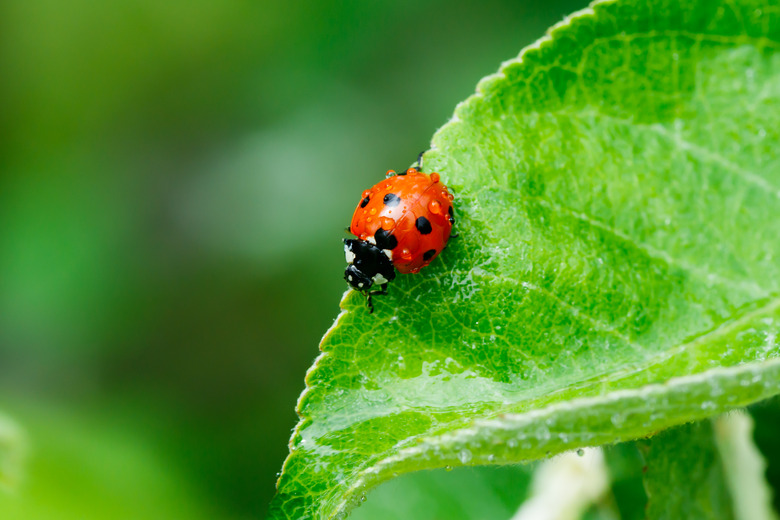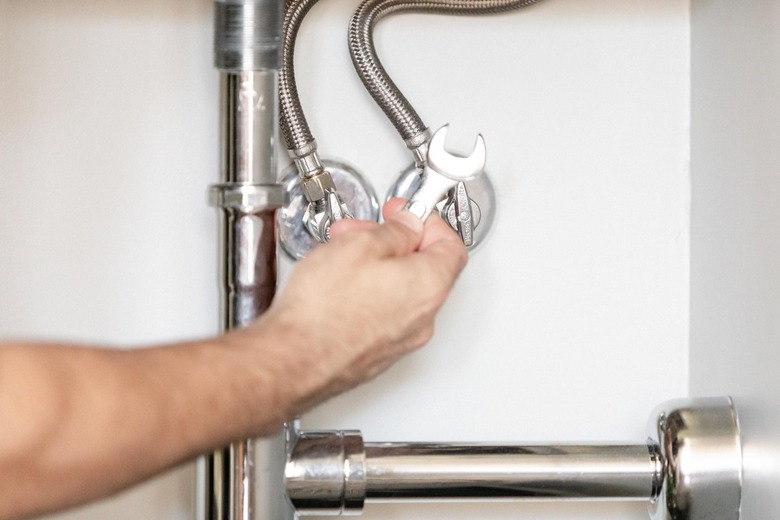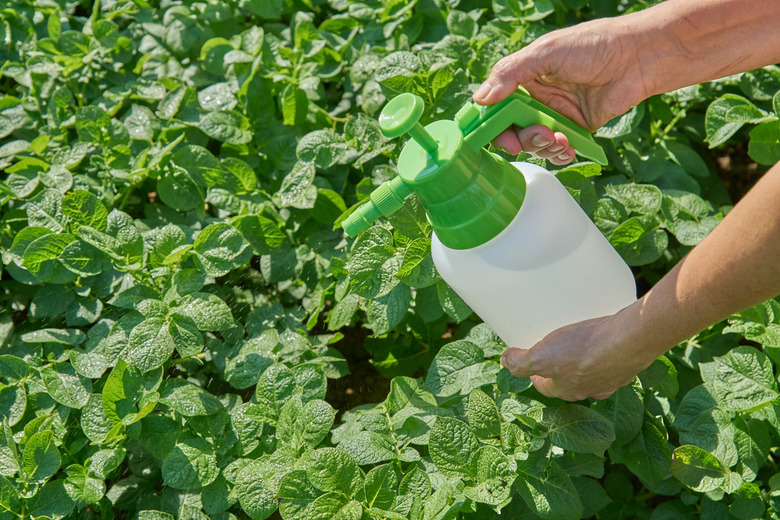Natural Pest Control Remedies That Keep The Bugs At Bay
We may receive a commission on purchases made from links.
Although some will stop at nothing to get rid of the creepy crawlies in their home — like heavy-duty pesticides and old-fashioned traps — others would like a more natural approach to pest control (or at least one that doesn't involve a bunch of chemicals you can't pronounce). Luckily, if you're in the latter camp, there are plenty of natural and safe alternatives and pest preventatives to chemical-laden pesticides. Just remember: Even if a pest control product claims to be "natural" or "nontoxic" doesn't mean that it's safe for your household to be exposed to it. Do your homework with any pest control product you purchase to keep kids, pets, and others who may be sensitive safe.
1. Keep It Clean
1. Keep It Clean
Let's be clear: Having insect visitors does not mean that you or your home are dirty. Insects and critters are attracted to places where they have ample access to food, water, and hiding places, and even clean homes can fulfill these needs. It takes only a few food crumbs or drips of water to make insects happy, so keeping things clean means tweaking your cleaning routine a bit rather than devoting your life to cleaning.
Store food in airtight, lidded containers and wipe down your kitchen counters and eating surfaces often. When ants are an issue, wipe your counter with a 50/50 solution of vinegar and water. The vinegar erases the pheromone trails that ants leave behind to lure other ants to the party in your pantry. Use a lidded trash can in your kitchen and for your outdoor garbage pail.
It's also a good idea to eliminate clutter around your house. Silverfish and cockroaches, for example, love damp paper, so now is a good time to clear all those old magazines out of the basement. When you do need to store clothing or other items, do so in plastic storage containers.
2. Vacuum Often
2. Vacuum Often
One of the easiest pest management DIYs you can do is to vacuum once a week and dust before you do so. A bonus: Regular vacuuming picks up dust mites and other potential allergens. This is particularly important if you have pets or have had flea problems in the past. Fleas aren't fussy and will happily drop eggs on your carpets.
It's also a good idea to periodically vacuum your upholstered furniture and your mattresses. This is another place where flea eggs can hang out as well as bedbugs and other insects. A quick vacuuming won't solve a full-fledged infestation of bedbugs, fleas, or anything else, but it can catch a few stray bugs before they become a problem. You can also minimize the number of dust mites and minimize bedbug risk by encasing your mattress in an insectproof mattress cover.
3. Check Your Plumbing
3. Check Your Plumbing
In addition to a food source, insects also need access to water. So to eliminate that access, check your plumbing for leaks and fix any that you find promptly. Examine water-using appliances as well, making sure they're draining as intended. An appliance malfunction could lead to water on the floor behind your washing machine or under your dishwasher.
Keeping your drains moving and free of clogs is also important. Insect pests like drain flies and other gross bugs can live in drain clogs, and slow drains can create standing pools of water. Sometimes, basements and other spaces are prone to high humidity and dampness. To keep pest problems at bay, run a dehumidifier in these spaces, making sure you empty it regularly or drain it properly.
Remember to check your attic during your search for unwanted water. Basements are notorious for being damp, but leaky roofs and condensation can cause dampness in your attic too, making pest control equally important there.
4. Protect the Perimeter
4. Protect the Perimeter
Bugs won't bother you if they can't get into your house. You'll probably never succeed at keeping them all out, but you can greatly improve your odds with a little home maintenance.
- Replace ripped screens and those with holes in them.
- Use caulk or expanding foam to seal any cracks or holes in your walls and to seal areas where pipes and conduits come into your home.
- Replace worn weatherstripping and caulk around windows and door frames as well.
- If you use a window unit for your air conditioner, apply weatherstripping around the unit, and take it out of the window as soon as you can in the fall.
- Switch to yellow bulbs in your outdoor lights, as they don't attract bugs.
- Mulch with stones rather than wood.
- Trim trees and other plants so that they don't touch your house and serve as a bridge for insects.
- If you have flower beds along your home's foundation, fill them with plants that insects don't like, including bee balm (Monarda spp.), chrysanthemum (Chrysanthemum spp.), dahlia (Dahlia pinnata), marigold (Tagetes spp.), and petunia (Petunia × atkinsiana).
- While you're working in the garden, move woodpiles and other debris further away from your home and rake up dead leaves that provide shelter for insects.
- Get rid of wheelbarrows and other containers that collect and hold stagnant water, which is a breeding ground for mosquitoes.
5. Beneficial Insects and Animals
5. Beneficial Insects and Animals
You don't want any insects inside your house at all, but you can help yourself by allowing certain bugs and animals in your outdoor space to do some organic pest control for you. There are many species of insects that eat or parasitize other insect species. These include ladybugs, some wasp species, many beetles, and lacewings.
The best way to attract these creatures is to plant native species in your garden. The beneficial insects that live in your area will recognize and be drawn to these plants, which they've evolved to find. Although you still don't want woodpiles and other debris too close to your home, you'll want to leave behind some mulch and rotting leaves if you want to attract good bugs.
Birds also eat insects, and you can attract them to your garden with birdhouses and a nice birdbath. Change the water in the birdbath often, however, so it doesn't stagnate and breed mosquitoes. Don't be too quick to trap or remove possums and other wildlife. Possums eat an incredible number of ticks, for example, and can help keep your lawn and garden free of these pests.
Your local extension office can give you a lot of information on the helpful insects that live where you do and can help you attract them to your outdoor space. Resist the urge to buy beneficial insects to release into your garden, though. If you have what they need, they'll come to you. If you don't, any insects you release in your garden will simply go elsewhere to have their needs met.
6. Diatomaceous Earth
6. Diatomaceous Earth
When preventive tactics fail, one of the best natural remedies for pest control is diatomaceous earth, which can control bugs both indoors and outdoors. Diatomaceous earth is a powder made of fossilized diatoms: tiny sea creatures that lived millions of years ago. Diatoms contain high amounts of silica, which dries out the oils and fats in insects' bodies when they walk across it. Because diatomaceous earth has rough surfaces, the insects also get cuts in their exoskeleton when walking through the powder, which speeds the drying out process.
Because it's made from fossils, diatomaceous earth is 100 percent natural. It's also nontoxic and won't harm children, pets, or wildlife. It can cause throat irritation if inhaled, however, so do exercise some caution when using it. You can simply spread a layer of diatomaceous earth in areas of insect activity or use a duster to force it into cracks and crevices where insects may be hiding. The application will continue to work as long as the powder stays dry.
7. Oil Sprays
7. Oil Sprays
If you find insects getting to the veggies in your garden before you do, an oil spray is a good way to solve the problem. Oil coats insects and essentially suffocates them, working particularly well on soft-bodied insects, like scale and aphids.
Any type of oil in your cupboards will work, including vegetable, olive, soybean, or cottonseed. If you want an oil known to have insecticidal qualities, choose neem oil, which smothers bugs and stops them from feeding. Neem oil is a natural product derived from neem trees (Azadirachta indica) and is considered nontoxic, but some children may have neem oil sensitivities.
To use the oil, simply dilute it in water in a spray bottle and spray your plants. Some plants are sensitive to oils, so test a hidden spot on your plants before you spray vigorously. Oil only works when it comes in direct contact with the insects, so reserve your spray treatment for active insects that you can see.
8. Pyrethrin
8. Pyrethrin
Pyrethrin is actually a combination of six chemicals found in chrysanthemum flowers. When applied to insects, pyrethrin causes paralysis and ultimately death. In order to work, the pyrethrin must come in direct contact with the insect, but it does not need to be ingested. Large and hardy insects can sometimes experience temporary paralysis but then recover from pyrethrin exposure. As a result, pyrethrin is often combined with other insecticides, so read the label carefully.
Pyrethrin comes in both powder and spray forms that you can use indoors and outdoors. While natural, this is a chemical that may not prove entirely safe. While generally low in toxicity to humans, pyrethrin is extremely toxic to fish and honeybees. Pyrethrin exposure has caused drooling, tremors, and difficulty breathing in dogs, and people exposed to pyrethrins have exhibited asthmalike symptoms. It's unclear whether there is a direct link to these symptoms and the pyrethrin exposure, however.
9. Pheromones and Sticky Traps
9. Pheromones and Sticky Traps
There is room for a little debate on this one. Because they use no insecticides, some folks argue that sticky traps could be considered natural pest control. Others feel that there isn't anything natural about glue.
Pheromone traps work by using natural pheromones to lure specific insects to them. These insects arrive at the trap looking for a hot date. Instead, they find themselves stuck to a glue board from which they can't escape. The downside to these traps is that they only work for certain bugs. If you have roaches, for instance, you'll need a trap that specifically uses roach pheromones.
Similar traps (like fly traps) use glue only and get placed where insects are likely to walk or land across them in their daily travels. Glue traps work best when set behind appliances, along walls, and in damp or dark places where insect activity is likely.
Because the traps are not poisonous, bugs trapped on glue may not die quickly. Many will struggle to free themselves until they die from sheer exhaustion. Others will slowly starve to death since they're unable to reach food or water. Some people have no qualms about this when it comes to creepy crawlies, but others find it inhumane.
References
- Ortho: How to Get Rid of Bugs Indoors
- National Pesticide Information Center: Diatomaceous Earth
- Washington State University Extension: Beneficial Insects, Spiders, and Other Mini-Creatures in Your Garden: Who They Are and How to Get Them to Stay
- Colorado State University Extension: Insect Control: Horticultural Oils
- National Pesticide Information Center: Neem Oil
- National Pesticide Information Center: Pyrethrins
- Illinois Department of Public Health: Pest Control – Do it Yourself or Hire a Professional?
- Teaxs A&M AgriLife Extension: What is a Sticky Trap?
- Arkansas Coopertive Extension Service: Pike County Agriculture and Natural Resources Newsletter Volume I Issue II


